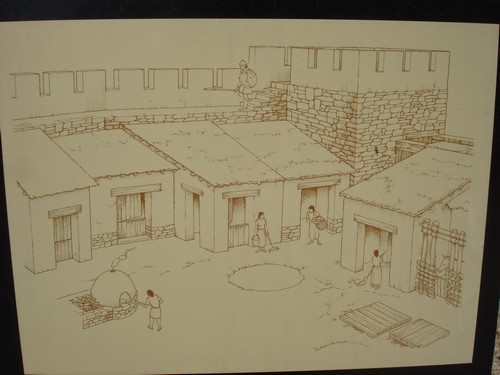Located high in the mountains around Lloret de Mar, but just 2 kms from the center, in the foothills of the Massif de Ardenya, and with stunning views, you’ll find an ancient Iberian settlement occupied by the tribe of the indiketas: a surveillance zone during a period of time that coincided with the arrival of the Romans in Ampurias, the Costa Brava region.

Puig Castellet iberian settlement offers impressive views over the Lloret the Mar and the sea
Research and excavations that have taken place during the twentieth century on this promontory located on the urbanization of Roca Grossa allow us to ensure that the Puig Castellet mainly served as a place to watch out. So it must be, because the views over the Tordera river from its mouth to Lloret de Mar are excellent, so that its inhabitants could warn other larger Iberian village located inside, Montbarbat, 6 kms away from the arrival of invaders.

Puig Castellet should be a little village inside a fortress like this drawing
This small walled city was not inhabited for a long time. It was created because of the insecurity before the Punic Wars between the Romans and Carthaginians along the coast, so we know it was occupied for a very delimited period of time: from 250 BC to 210 BC.
It was inhabited by vigilant warriors and their families. The remains we now find, subsoil excavated in the mid-twentieth century (especially between 1975 and 1986) show a pentagonal wall and defense towers, on a terrain about 650 m2, which contains eleven rectangular stays in which an area was dedicated to private affairs and the other to work. Each of these rooms is attached to the wall to make maximum use of space.

Puig Castellet iberian settlement, in Lloret de Mar, is well arranged to enjoy a historical visit
In addition to the homes, in the central area of the enclosure you can distinguish communal areas as holes in the rock mass, to collect rainwater or to filter the water pumped out from the underground, septic waste, stores, ovens for baking bread or for pottery, etc.
The Iberians were the inhabitants who occupied the peninsula before the Roman arrived, at least from the s. VI BC. Divided into tribes, one that occupied what we now know as the Ampurdan region were indiketas, who, among other cultural hits, minted its own currency and maintained commercial ties with Greek and Phoenician peoples.

Ancient home and food store on the Puig Castellet iberian settlement, in Lloret de Mar, Costa Brava
The site of Puig de Castellet is part of the local thematic route “Iberian route,” one of the most interesting cultural routes along the Costa Brava.







